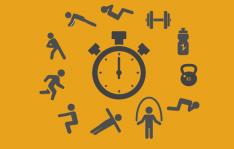Breathe Right
Here's how Mindy Solkin, a New York City-based coach, teaches runners to engage their diaphragms.
Open Your Mouth
Your mouth is larger than your nostrils, so it's more effective at taking in oxygen. Also, keeping your mouth open keeps your face more relaxed, which makes it easier to breathe deeply.Breathe in Patterns
Coordinating your inhales and exhales with your footfalls develops diaphragmatic strength. Start with a 2-2 pattern-breathe in while stepping left, right; breathe out while stepping left, right. Advance to 3-3 (breathe in, step left, right, left; breathe out, step right, left, right), and then a 4-4 pattern.Breath Enhancers
Cross-training exercises that reduce huffing and puffingThese three Pilates moves strengthen the diaphragm, stretch tight muscles, and improve posture-all of which help you run longer with less effort. Practice each exercise two or three times a week before you run.
1) The Hundred
Lie on your back, knees bent, feet flat on the floor. Keep your arms at your sides, palms down. Inhale and lift your head, neck, shoulders, and arms off the ground. Lift your knees and extend your feet so your legs are straight and at a 45-degree angle to the floor. Take five short breaths in and five short breaths out. While doing so, pump your arms, moving them in a controlled up and down manner. Do a cycle of 10 full breaths-each breath includes five inhales and five exhales. After you do 10 complete breaths, you will have completed 100 arm pumps.
The Payoff: Teaches controlled breathing, so that your inhales and exhales are balanced. Bonus: Builds strong abdominals.
2) The Swan
Lie face down with your palms flat under your shoulders (as if you were going to do a pushup). Look down so your neck is in line with your spine. Inhale and slowly lift your head, neck, shoulders, and chest as you press your hands into the ground. Keep a slight bend in your elbows. As you exhale, slowly lower yourself back down, chest first, then shoulders, neck, chin, and head. To avoid discomfort in your back, concentrate on pulling your shoulders back to open up your chest. Repeat 10 times.
The Payoff: Opens up the chest and deepens your lung capacity to correct shallow breathing.
3) Standing Chest Expansion
Stand up straight with your feet shoulder-width apart, your knees slightly bent, and your arms at your sides. Inhale and sweep your arms out and up so that your biceps are near your ears and your palms are facing each other. Exhale and lower your arms back down to your sides. Repeat four times, concentrating on breathing deep and opening your chest.
The Payoff: Stretches the intercostal muscles (which lie between the ribs), relaxes the shoulders, engages the diaphragm and pelvic floor, and helps balance breathing between the left and right lungs.
READ THIS NEXT: 4 Tips to Master Your Breathing Technique During the Swim
- 2
- of
- 2








Discuss This Article